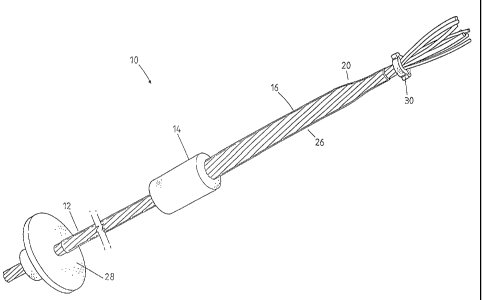Some of the information on this Web page has been provided by external sources. The Government of Canada is not responsible for the accuracy, reliability or currency of the information supplied by external sources. Users wishing to rely upon this information should consult directly with the source of the information. Content provided by external sources is not subject to official languages, privacy and accessibility requirements.
Any discrepancies in the text and image of the Claims and Abstract are due to differing posting times. Text of the Claims and Abstract are posted:
| (12) Patent: | (11) CA 2458948 |
|---|---|
| (54) English Title: | A YIELDING ROCK BOLT |
| (54) French Title: | BOULON D'ANCRAGE COULISSANT |
| Status: | Deemed expired |
| (51) International Patent Classification (IPC): |
|
|---|---|
| (72) Inventors : |
|
| (73) Owners : |
|
| (71) Applicants : |
|
| (74) Agent: | FETHERSTONHAUGH & CO. |
| (74) Associate agent: | |
| (45) Issued: | 2011-07-12 |
| (86) PCT Filing Date: | 2002-09-06 |
| (87) Open to Public Inspection: | 2003-03-13 |
| Examination requested: | 2007-09-04 |
| Availability of licence: | N/A |
| (25) Language of filing: | English |
| Patent Cooperation Treaty (PCT): | Yes |
|---|---|
| (86) PCT Filing Number: | PCT/AU2002/001223 |
| (87) International Publication Number: | WO2003/021081 |
| (85) National Entry: | 2004-02-27 |
| (30) Application Priority Data: | |||||||||
|---|---|---|---|---|---|---|---|---|---|
|
A yielding rock bolt (10) arranged to be inserted into a hole in a rock
surface. The rock bolt comprises a shaft (12) having a widened portion (26)
adjacent a first end (20) thereof, arranged, in use, adjacent an inner end of
the hole. The rock bolt (10) also includes an anchor member (14) arranged to
be secured within the hole in the rock surface. A longitudinal bore is
provided in the anchor member (14) to receive a second end of the shaft (12),
the longitudinal bore being of a diameter slightly less than that of the
widened portion (20) of the shaft (12). A rock face engaging means (28) is
provided adjacent a second end of the shaft (12) to secure the second end of
the shaft (12) adjacent the rock face. Movement of the rock face causes the
widened portion (26) of the shaft (12) to be pulled through the longitudinal
bore in the anchor member (14).
L'invention concerne un boulon d'ancrage coulissant (10) destiné à être inséré dans un trou formé dans une surface rocheuse. Ce boulon d'ancrage comprend une tige (12) présentant une partie élargie (26), adjacente à une première extrémité (20) de ladite tige et placée, en cours d'utilisation, de façon adjacente à une extrémité intérieure du trou. Ce boulon d'ancrage (10) comprend également un élément d'ancrage (14) destiné à être fixé solidement à l'intérieur du trou formé dans la surface rocheuse. Un alésage longitudinal, formé à l'intérieur dudit élément d'ancrage (14), sert à recevoir une seconde extrémité de la tige (12), cet alésage longitudinal présentant un diamètre légèrement inférieur à celui de la partie élargie (20) de la tige (12). Un moyen (28), s'engageant vers la surface rocheuse et adjacent à une seconde extrémité de la tige (12), sert à fixer solidement la seconde extrémité de la tige (12) adjacente à la surface rocheuse. La partie élargie (26) de la tige (12) est tirée à travers l'alésage longitudinal, formé dans l'élément d'ancrage (14, par le mouvement de la surface rocheuse.
Note: Claims are shown in the official language in which they were submitted.
Note: Descriptions are shown in the official language in which they were submitted.

For a clearer understanding of the status of the application/patent presented on this page, the site Disclaimer , as well as the definitions for Patent , Administrative Status , Maintenance Fee and Payment History should be consulted.
| Title | Date |
|---|---|
| Forecasted Issue Date | 2011-07-12 |
| (86) PCT Filing Date | 2002-09-06 |
| (87) PCT Publication Date | 2003-03-13 |
| (85) National Entry | 2004-02-27 |
| Examination Requested | 2007-09-04 |
| (45) Issued | 2011-07-12 |
| Deemed Expired | 2017-09-06 |
There is no abandonment history.
Note: Records showing the ownership history in alphabetical order.
| Current Owners on Record |
|---|
| GARFORD PTY LTD. |
| Past Owners on Record |
|---|
| MALTBY, DAVID |
| MINE ANCHOR SYSTEMS PTY LTD. |